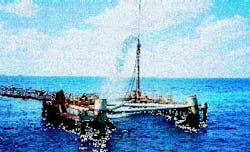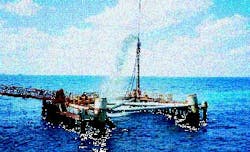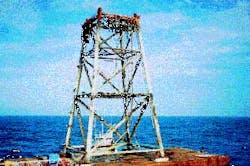Offshore Petroleum Operations Explosives remain preferred method for platform abandonment
Allan Pulsipher, William Daniel IV
Louisiana State University Baton Rouge, La.
James E. Kiesler
Consultant Morgan City, La.
Vance Mackey III
Chevron Petroleum Technology Co. Houston
Jetting out a mud plug is often required before explosives can be run down a pile. Seen here is Unocal's High Island A-341 jacket that was toppled in place in 239 ft of water. (Photo courtesy of Unocal Corp.)
Economics and safety concerns indicate that methods involving explosives remain the most practical and cost-effective means for abandoning oil and gas structures in the Gulf of Mexico.
A decade has passed since 51 dead sea turtles, many endangered Kemp's Ridleys, washed ashore on the Texas coast shortly after explosives helped remove several offshore platforms.
Although no relationship between the explosions and the dead turtles was ever established, in response to widespread public concern, the U.S. Minerals Management Service (MMS) and National Marine Fisheries Service (NMFS) implemented regulations limiting the size and timing of explosive charges. Also, more importantly, they required that operators pay for observers to survey waters surrounding platforms scheduled for removal for 48 hr before any detonations.
If observers spot sea turtles or marine mammals within the danger zone, the platform abandonment is delayed until the turtles leave or are removed. However, concern about the effects of explosives on marine life remains.
GAO study
A 1994 report by the U.S. General Accounting Office, alleged MMS has not adequately studied the costs and benefits of nonexplosive technology that would eliminate or minimize the risk of environmental damage from removing offshore structures.1
The GOA further added that certain actions by MMS may actually encourage explosives. For example, in 1993 MMS proposed relaxing limits on explosives without having adequately documented the need for larger explosive charges or the probability of harmful effects on marine life.
As a response to the GAO report, MMS commissioned a study by the Marine Board of the National Research Council focused on the uses and environmental effects of explosives.2
Marine Board report
The Marine Board report is a consensus document reflecting diverse viewpoints and subject to different interpretations. In the authors' view, it does not support GAO's characterization cited previously. On the contrary, the report presents a persuasive case for the continued use of explosives. The recommendations it makes for changes in existing regulations constitute fine tuning, featuring as much loosening as tightening.
For example, the committee concluded the NMFS observer program seems to have worked very well. No marine mammals and only one turtle have been injured since the program started. The committee recommended that the program be maintained but that the predetonation observation period could be safely shortened from 48 to 24 hr.
However, the committee also found that concern over the effects of explosives on fish appears to have grown. Offshore platforms provide habitat for reef fish. Some reef fish such as red snapper are highly valued by recreational and commercial fisherman. The available evidence indicates that almost all fish resident at platforms removed with explosives are killed.
The committee concluded that, although there was no evidence that the number of fish killed by explosives during removals had had, or would have, a significant effect on fish populations, more data needed to be gathered.
The principal weaknesses in existing regulations identified by the committee were the 50 lb/charge and eight-detonation limit stipulations in MMS's generic permit that may have perverse effects with respect to fish kills.
Because the 50-lb limit is routinely approved and explosives are inexpensive, 50-lb charges may have become an industry minimum as well as a maximum.
Similarly, the eight-explosion limit may increase fish kill if the removal requires more than eight explosions because new fish may be attracted to the site due to a chumming effect from the fish killed in the previous explosion.
To correct these problems, the committee recommended that the oil and gas industry prepare a standard of practice for explosives that relates the charge size to the job at hand, as well as incorporate strategies for mitigating environmental effects into the removal work plan.
With respect to GAO's charge that MMS had discouraged rather than encouraged the development and use of nonexplosive techniques, the committee found that the private sector was involved in considerable development work, both for economic motives (nonexplosive techniques are frequently employed when the platform is scheduled for reuse) as well as a hedge against regulations prohibiting or further limiting explosives.
The principal obstacle for nonexplosive techniques identified by the committee was MMS's requirement that platforms must be severed a least 15 ft below the mudline. Although the committee was unable to determine the historic rationale for this requirement (it is rumored to lie in the Department of Defense) a cut at a deeper depth does dampen the lethality of the explosion. The reduction in lethality, however, appears small and would have to be coupled with other strategies, such as smaller, advanced explosive charges and effective fish repeling devices, to affect significantly fish mortality.
The minimum 15-ft depth requirement makes nonexplosive techniques difficult because most would require divers to excavate and work in a wide trench around each platform element to be severed. To alleviate this problem, the committee recommended that MMS raise the cutting depth to 3 ft below the mudline and incorporate into its permitting process the flexibility to allow development and field deployment of nonexplosive or reduced-charge explosive techniques.
Costs and benefits
The committee spent considerable time studying the cost side of the benefit/cost ratio. It concluded that available evidence on sea turtles and marine mammals does not support prohibiting or further restricting explosives for platform removal; however, the effects on fish population dynamics are uncertain. Also, prohibiting explosives would incur risks to divers and other offshore workers and would substantially increase platform removal costs.
Table 1 [41880 bytes] shows the estimated cost breakdown for alternative removal technologies for an eight-pile production and drilling platform with six wells in 150 ft of water. Actual removal costs vary widely depending on type, age, and condition of a platform and the water depth, soil type, weather, etc. Table 1 [41880 bytes] was based on estimates for a "typical removal" by Chevron U.S.A. Inc., one of the largest offshore operators in the Gulf.
In Table 1 [41880 bytes], the cost differences between explosive and nonexplosive techniques are very conservative because all operations are assumed "trouble-free." However the consensus of the committee and the industry experts testifying before it was that the principal disincentive of nonexplosive techniques was precisely that nonexplosive operations were much less likely to be "trouble-free."
Moreover, as illustrated in Table 1 [41880 bytes], the reason that explosive removals are less costly is that the derrick barge and severing costs are so much lower. In most circumstances in which "trouble" is encountered, these two cost categories are both likely to be interdependent and to escalate rapidly, in concert.
Toppling platforms in place under rigs-to-reefs programs, using explosive cutting, is by far the least expensive disposal method.
Unocal's West Cameron 280 #5 jacket was removed from 93 ft of water and scrapped onshore. (Photo courtesy of Unocal Corp.)
Only about 10% of the platforms removed to date in the Gulf have entered such programs. There are a number of reasons for the low participation rate. Most platforms removed to date were smaller platforms in shallow waters that would have had to be towed to deeper waters under existing programs. This cost is not included in Table 1 [41880 bytes].
Furthermore, the Louisiana rigs-to-reefs program only allows for toppling platforms located in relatively delimited planning areas. For platforms in shallow waters, the towing cost to a designated planning area makes the rigs-to-reef option a financial loser.
Texas is more accommodating but still restricts toppling if there is a possibility it would affect navigation or other uses.
Table 2 [35412 bytes], also prepared for the Marine Board report, uses the cost breakdown shown in Table 1 [41880 bytes] to estimate removal costs for typical four-pile and eight-pile platforms in different water depths. Removal costs of a four-pile platform in 50 ft of water average about 25% of the cost of an eight-pile platform in 250 ft of water.
The Marine Board report did not include estimates of total, industry-wide costs of explosive and nonexplosive removal techniques. Fig. 1 [50605 bytes] shows calculations by the authors of the total cost for removing all platforms now installed within federal waters in the Gulf of Mexico. This estimate applied the cost data from Table 2 [35412 byt] to each existing platform that had data available as to type of platform and water depth.
Other attributes obviously would affect removal costs. These estimates should be viewed as rough approximations. Nevertheless, they indicate that substantial costs would be incurred if explosives were prohibited in the Gulf.
Two qualifications should be kept in mind in interpreting Fig. 1 [50605 bytes]. First, the totals reflect the conservative, "trouble-free" assumptions underlying the estimates in Tables 1 [41880 bytes] and 2 [35412 bytes]. Second, the estimates include only existing platforms in place as of 1995. During the next decade, the number of platforms installed is expected to be about the same as the number removed. Thus, the eventual total cost and the cost differences will be considerably greater than shown in Fig. 1 [50605 bytes].
Neither the committee nor the authors have attempted to quantitatively estimate the benefits that may be associated with a prohibition or further restrictions on explosives for platform removal. One, of course, could estimate the value of the fish killed during the platform removal process, but the data on fish likely to be resident at a platform that was presented to the committee, in the authors' view, was fragmentary and varied too widely to support meaningful estimates.
Moreover, the committee was unable to find or to deduce any effects of the additional fish mortality due to explosions on fish populations. Without such population effects, the effect of removals clearly would be insignificant.
Rough calculations comparing reasonable estimates of fish mortalities associated with platform removals and fish mortalities attributable to other causes susceptible to regulation (such as regulations designed to reduce the bycatch from trawling) indicate that the direct regulation of fishing operations would be more efficient and cost-effective for mitigating any such effects on fish populations.
Nevertheless, efficient public policy requires objective and comprehensive comparisons of costs and benefits from alternative courses. Because a start has been made on the cost side, perhaps, the sensible way to continue is to estimate the benefits of nonexplosive removal and onshore disposal that seems to be the standard that critics of current regulations and practices implicitly endorse.
References
1. General Accounting Office, Offshore Oil and Gas Resources: Interior Can Improve Its Management of Lease Abandonment, GAO/RCED-94-82, 1994.
2. National Research Council, Marine Board, Committee on Techniques for Removing Fixed Offshore Structures, An Assessment of Techniques for Removing Offshore Structures, Washington DC, National Academy Press, 1996.
The Authors
Allan G. Pulsipher is the director of the policy analysis program and the interim executive director at the Center for Energy Studies at Louisiana State University. He was a member of the Marine Board committee responsible for An Assessment of Techniques for Removing Offshore Structures, and he organized and chaired an international workshop on Offshore Lease Abandonment and Platform Disposal in April in New Orleans.Pulsipher has a BA from the University of Colorado and a PhD from Tulane University, both in economics.
James E. Kiesler is a consultant in Morgan City, La. Previously he was general manager of Total Abandonment Services (TAS), an alliance of Halliburton Energy Services and Global Industries Ltd. He has 27 years' experience in the offshore construction industry and has been involved in the installation of over 500 platforms and the removal of more than 200. He was a member of the Marine Board committee responsible for An Assessment of Techniques for Removing Offshore Structures.Kiesler has a BS in civil engineering from Purdue University.
Vance Mackey is a design and construction engineer with Chevron Petroleum Technology Co., where he is a member of a team which coordinates Chevron's Gulf of Mexico abandonment program. He has been a project manager or consultant on over 40 abandonment projects. Mackey has a BS in civil engineering from the University of Southwest Louisiana.
William Daniel IV is a research associate at the LSU Center for Energy Studies. He has worked as an engineer for major companies and had his own oil and gas company. He has a BS and MS in petroleum engineering from LSU as well as an MBA from the University of Tulsa.Copyright 1996 Oil & Gas Journal. All Rights Reserved.






